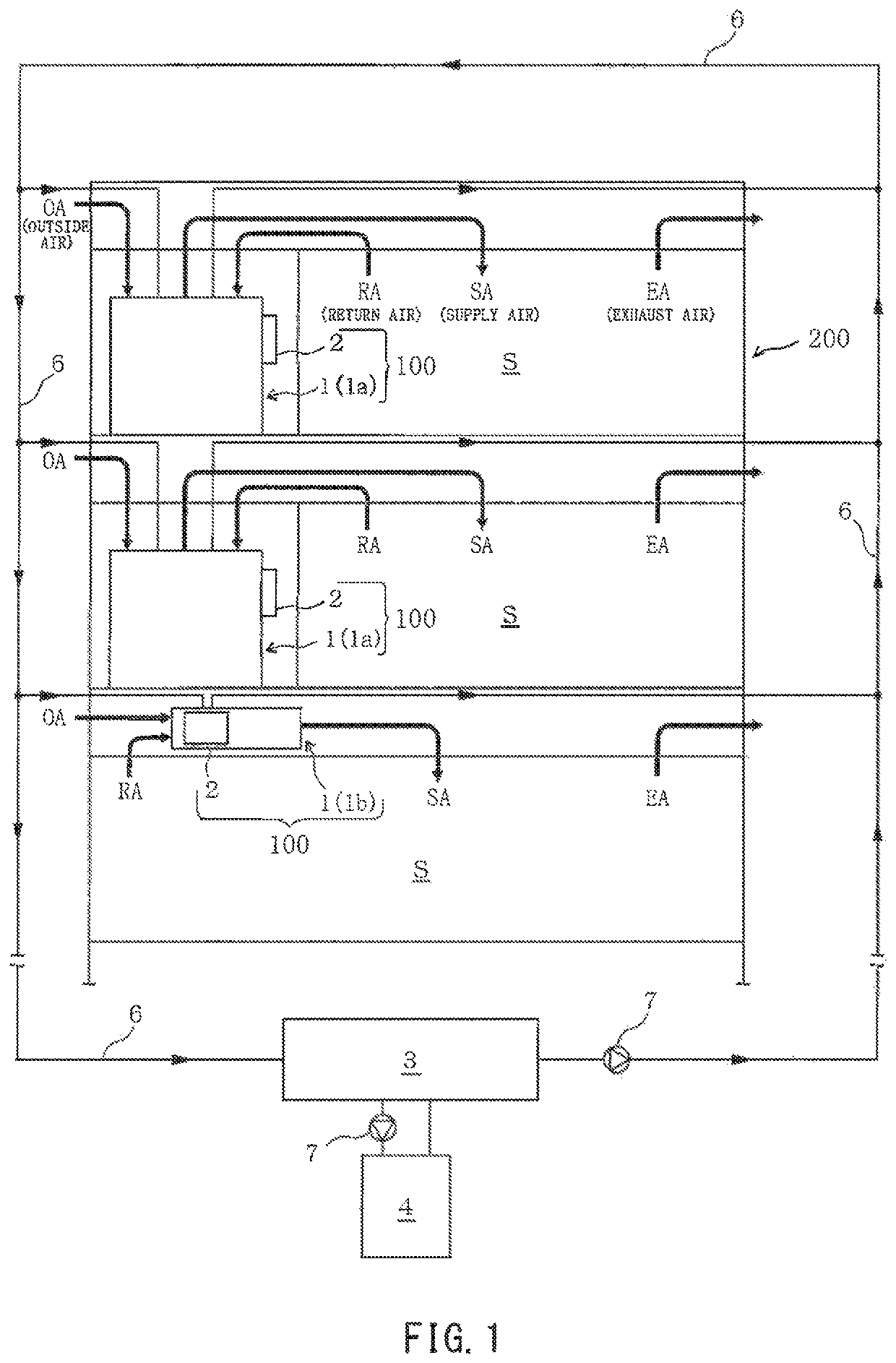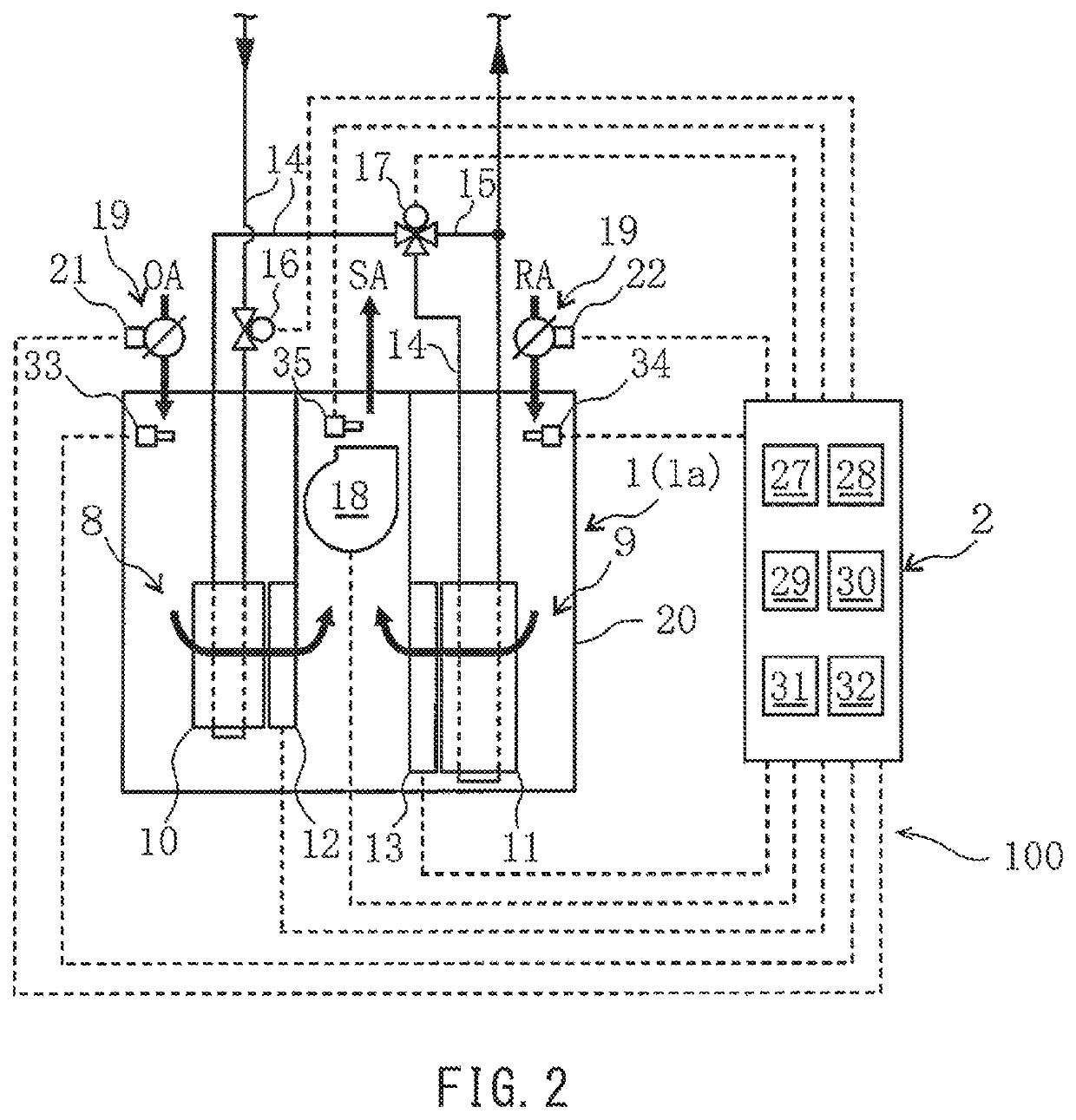Air conditioning system
a technology of air conditioning system and air intake, which is applied in ventilation systems, lighting and heating apparatuses, heating types, etc., to achieve the effects of low heat exchange energy, waste of energy consumption, and high heat exchange energy
- Summary
- Abstract
- Description
- Claims
- Application Information
AI Technical Summary
Benefits of technology
Problems solved by technology
Method used
Image
Examples
embodiment 1
[0028]FIG. 2 shows the internal configuration of the air conditioner 1. The air conditioner 1 includes: an outside air passage 8, through which outside air serving as air-conditioning air flows; and a return air passage 9, through which return air serving as air-conditioning air flows. The air conditioner 1 includes the following components in its casing 20: an outside air heat exchanger 10, at which the outside air serving as air-conditioning air exchanges heat with the heat exchange medium; a return air heat exchanger 11, at which the return air serving as air-conditioning air exchanges heat with the heat exchange medium; an outside air vaporizing humidifier 12 configured to humidify the outside air of the outside air passage 8 by utilizing evaporation of water; a return air vaporizing humidifier 13 configured to humidify the return air of the return air passage 9 by utilizing evaporation of water; and an air blower 18. Each humidifier 12 or 13 performs the humidification when pow...
embodiment 2
[0046]FIG. 5 shows a configuration that is a result of eliminating the outside air vaporizing humidifier 12 from the air conditioner 1 shown in FIG. 2, and instead, incorporating a steam humidifier 40 into the air conditioner 1 shown in FIG. 2. The steam humidifier 40 is configured to humidify, between the air-conditioning air of the outside air passage 8 and the air-conditioning air of the return air passage 9, at least the air-conditioning air (outside air) of the outside air passage 8 by utilizing steam. In addition, the air conditioner control device 2 includes, instead of the first vaporizing cooler 31, the following components: a humidifying heater 41 configured to operate the steam humidifier 40 to heat the air-conditioning air while preventing the air-conditioning air from exchanging heat with the heat exchange medium; and a second vaporizing cooler 42 configured to operate the return air vaporizing humidifier 13 to perform vaporization cooling of the return air while preven...
embodiment 3
[0051]FIG. 6 shows a configuration that is a result of eliminating the outside air damper 21, the return air damper 22, and the air blower 18 from the embodiment shown in FIG. 2, and instead, incorporating an outside-air blower 45 provided on the outside air passage 8 and a return-air blower 46 provided on the return air passage 9 into the embodiment shown in FIG. 2. The outside-air blower 45 and the return-air blower 46 serve as the air volume adjusting device 19. The outside-air blower 45 and the return-air blower 46 are capable of adjusting the air volume of the outside air of the outside air passage 8 and the air volume of the return air of the return air passage 9 through the control of increasing / decreasing the rotational speed of each of the blowers 45 and 46. Since the other configuration features and operation examples of Embodiment 3 are the same as those of the embodiment shown in FIG. 2, the description thereof is omitted.
PUM
 Login to View More
Login to View More Abstract
Description
Claims
Application Information
 Login to View More
Login to View More - R&D
- Intellectual Property
- Life Sciences
- Materials
- Tech Scout
- Unparalleled Data Quality
- Higher Quality Content
- 60% Fewer Hallucinations
Browse by: Latest US Patents, China's latest patents, Technical Efficacy Thesaurus, Application Domain, Technology Topic, Popular Technical Reports.
© 2025 PatSnap. All rights reserved.Legal|Privacy policy|Modern Slavery Act Transparency Statement|Sitemap|About US| Contact US: help@patsnap.com



